Stochastic Label Refinery: Toward Better Target Label Distribution
Xi Fang,
Jiancheng Yang,
Bingbing Ni

Auto-TLDR; Stochastic Label Refinery for Deep Supervised Learning
Similar papers
Knowledge Distillation with a Precise Teacher and Prediction with Abstention

Auto-TLDR; Knowledge Distillation using Deep gambler loss and selective classification framework
Abstract Slides Poster Similar
Energy-Constrained Self-Training for Unsupervised Domain Adaptation
Xiaofeng Liu, Xiongchang Liu, Bo Hu, Jun Lu, Jonghye Woo, Jane You

Auto-TLDR; Unsupervised Domain Adaptation with Energy Function Minimization
Abstract Slides Poster Similar
Iterative Label Improvement: Robust Training by Confidence Based Filtering and Dataset Partitioning
Christian Haase-Schütz, Rainer Stal, Heinz Hertlein, Bernhard Sick

Auto-TLDR; Meta Training and Labelling for Unlabelled Data
Abstract Slides Poster Similar
Rethinking of Deep Models Parameters with Respect to Data Distribution
Shitala Prasad, Dongyun Lin, Yiqun Li, Sheng Dong, Zaw Min Oo

Auto-TLDR; A progressive stepwise training strategy for deep neural networks
Abstract Slides Poster Similar
Knowledge Distillation Beyond Model Compression
Fahad Sarfraz, Elahe Arani, Bahram Zonooz

Auto-TLDR; Knowledge Distillation from Teacher to Student
Abstract Slides Poster Similar
Progressive Unsupervised Domain Adaptation for Image-Based Person Re-Identification
Mingliang Yang, Da Huang, Jing Zhao

Auto-TLDR; Progressive Unsupervised Domain Adaptation for Person Re-Identification
Abstract Slides Poster Similar
Towards Robust Learning with Different Label Noise Distributions
Diego Ortego, Eric Arazo, Paul Albert, Noel E O'Connor, Kevin Mcguinness

Auto-TLDR; Distribution Robust Pseudo-Labeling with Semi-supervised Learning
Semi-Supervised Domain Adaptation Via Selective Pseudo Labeling and Progressive Self-Training

Auto-TLDR; Semi-supervised Domain Adaptation with Pseudo Labels
Abstract Slides Poster Similar
Exploiting Knowledge Embedded Soft Labels for Image Recognition
Lixian Yuan, Riquan Chen, Hefeng Wu, Tianshui Chen, Wentao Wang, Pei Chen

Auto-TLDR; A Soft Label Vector for Image Recognition
Abstract Slides Poster Similar
FastSal: A Computationally Efficient Network for Visual Saliency Prediction

Auto-TLDR; MobileNetV2: A Convolutional Neural Network for Saliency Prediction
Abstract Slides Poster Similar
Meta Soft Label Generation for Noisy Labels

Auto-TLDR; MSLG: Meta-Learning for Noisy Label Generation
Abstract Slides Poster Similar
P-DIFF: Learning Classifier with Noisy Labels Based on Probability Difference Distributions
Wei Hu, Qihao Zhao, Yangyu Huang, Fan Zhang

Auto-TLDR; P-DIFF: A Simple and Effective Training Paradigm for Deep Neural Network Classifier with Noisy Labels
Abstract Slides Poster Similar
Improving Model Accuracy for Imbalanced Image Classification Tasks by Adding a Final Batch Normalization Layer: An Empirical Study
Veysel Kocaman, Ofer M. Shir, Thomas Baeck

Auto-TLDR; Exploiting Batch Normalization before the Output Layer in Deep Learning for Minority Class Detection in Imbalanced Data Sets
Abstract Slides Poster Similar
Unsupervised Domain Adaptation for Person Re-Identification through Source-Guided Pseudo-Labeling
Fabian Dubourvieux, Romaric Audigier, Angélique Loesch, Ainouz-Zemouche Samia, Stéphane Canu

Auto-TLDR; Pseudo-labeling for Unsupervised Domain Adaptation for Person Re-Identification
Abstract Slides Poster Similar
Confidence Calibration for Deep Renal Biopsy Immunofluorescence Image Classification
Federico Pollastri, Juan Maroñas, Federico Bolelli, Giulia Ligabue, Roberto Paredes, Riccardo Magistroni, Costantino Grana

Auto-TLDR; A Probabilistic Convolutional Neural Network for Immunofluorescence Classification in Renal Biopsy
Abstract Slides Poster Similar
Local Clustering with Mean Teacher for Semi-Supervised Learning
Zexi Chen, Benjamin Dutton, Bharathkumar Ramachandra, Tianfu Wu, Ranga Raju Vatsavai

Auto-TLDR; Local Clustering for Semi-supervised Learning
Semi-Supervised Person Re-Identification by Attribute Similarity Guidance
Peixian Hong, Ancong Wu, Wei-Shi Zheng
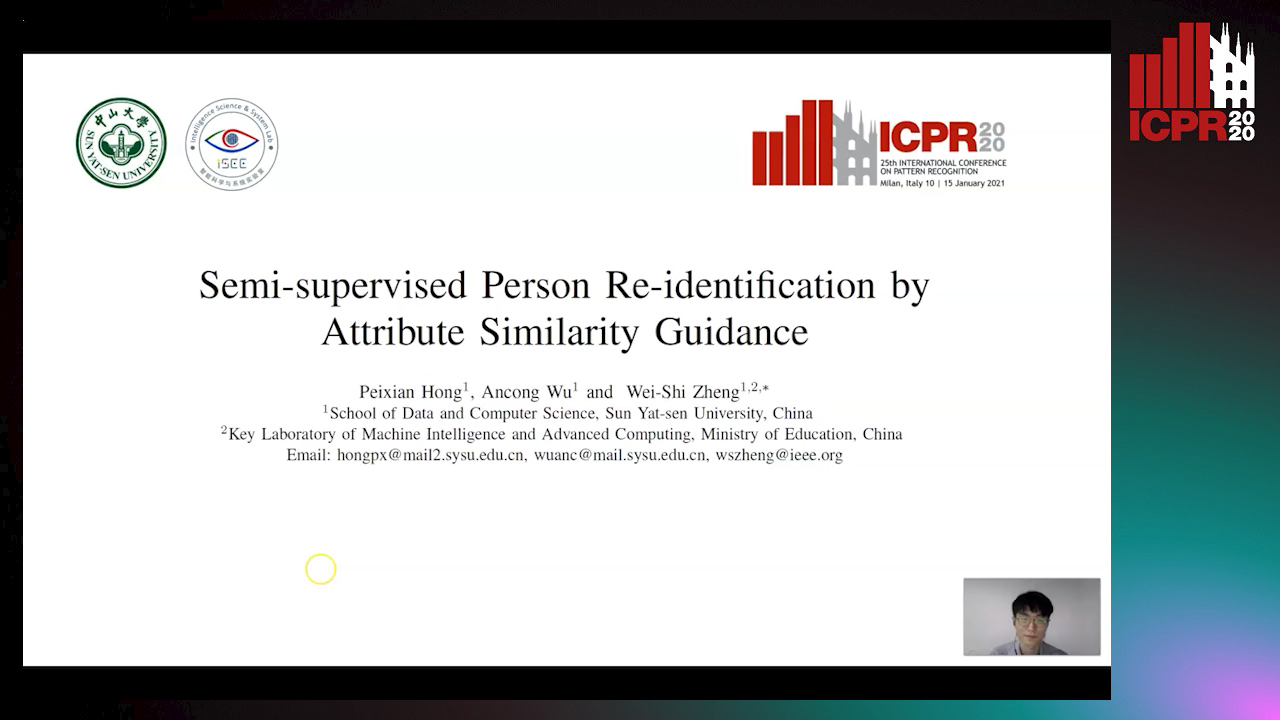
Auto-TLDR; Attribute Similarity Guidance Guidance Loss for Semi-supervised Person Re-identification
Abstract Slides Poster Similar
Generative Latent Implicit Conditional Optimization When Learning from Small Sample

Auto-TLDR; GLICO: Generative Latent Implicit Conditional Optimization for Small Sample Learning
Abstract Slides Poster Similar
Teacher-Student Competition for Unsupervised Domain Adaptation
Ruixin Xiao, Zhilei Liu, Baoyuan Wu

Auto-TLDR; Unsupervised Domain Adaption with Teacher-Student Competition
Abstract Slides Poster Similar
Progressive Cluster Purification for Unsupervised Feature Learning
Yifei Zhang, Chang Liu, Yu Zhou, Wei Wang, Weiping Wang, Qixiang Ye

Auto-TLDR; Progressive Cluster Purification for Unsupervised Feature Learning
Abstract Slides Poster Similar
Dealing with Scarce Labelled Data: Semi-Supervised Deep Learning with Mix Match for Covid-19 Detection Using Chest X-Ray Images
Saúl Calderón Ramirez, Raghvendra Giri, Shengxiang Yang, Armaghan Moemeni, Mario Umaña, David Elizondo, Jordina Torrents-Barrena, Miguel A. Molina-Cabello

Auto-TLDR; Semi-supervised Deep Learning for Covid-19 Detection using Chest X-rays
Abstract Slides Poster Similar
Making Every Label Count: Handling Semantic Imprecision by Integrating Domain Knowledge
Clemens-Alexander Brust, Björn Barz, Joachim Denzler

Auto-TLDR; Class Hierarchies for Imprecise Label Learning and Annotation eXtrapolation
Abstract Slides Poster Similar
Efficient Online Subclass Knowledge Distillation for Image Classification
Maria Tzelepi, Nikolaos Passalis, Anastasios Tefas

Auto-TLDR; OSKD: Online Subclass Knowledge Distillation
Abstract Slides Poster Similar
Adaptive Distillation for Decentralized Learning from Heterogeneous Clients
Jiaxin Ma, Ryo Yonetani, Zahid Iqbal
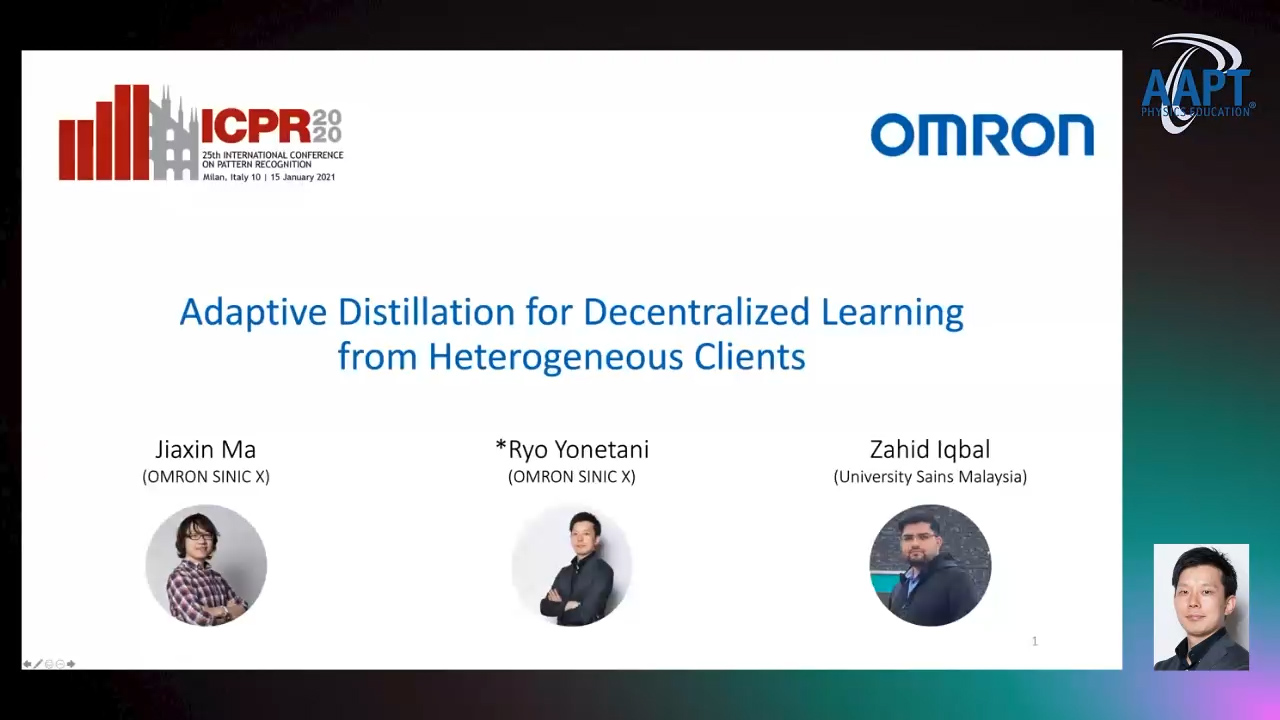
Auto-TLDR; Decentralized Learning via Adaptive Distillation
Abstract Slides Poster Similar
Smart Inference for Multidigit Convolutional Neural Network Based Barcode Decoding
Duy-Thao Do, Tolcha Yalew, Tae Joon Jun, Daeyoung Kim

Auto-TLDR; Smart Inference for Barcode Decoding using Deep Convolutional Neural Network
Abstract Slides Poster Similar
Contextual Classification Using Self-Supervised Auxiliary Models for Deep Neural Networks
Sebastian Palacio, Philipp Engler, Jörn Hees, Andreas Dengel

Auto-TLDR; Self-Supervised Autogenous Learning for Deep Neural Networks
Abstract Slides Poster Similar
Feature Fusion for Online Mutual Knowledge Distillation
Jangho Kim, Minsung Hyun, Inseop Chung, Nojun Kwak
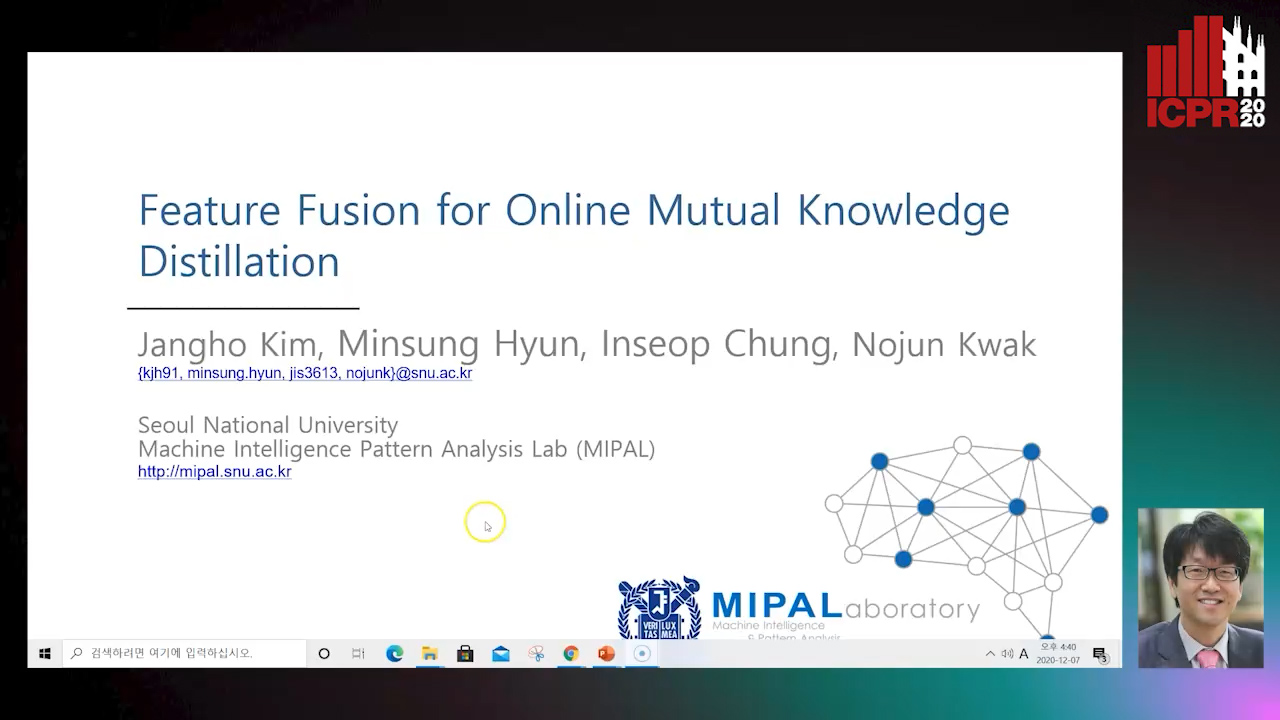
Auto-TLDR; Feature Fusion Learning Using Fusion of Sub-Networks
Abstract Slides Poster Similar
Nearest Neighbor Classification Based on Activation Space of Convolutional Neural Network
Xinbo Ju, Shuo Shao, Huan Long, Weizhe Wang

Auto-TLDR; Convolutional Neural Network with Convex Hull Based Classifier
Channel Planting for Deep Neural Networks Using Knowledge Distillation
Kakeru Mitsuno, Yuichiro Nomura, Takio Kurita

Auto-TLDR; Incremental Training for Deep Neural Networks with Knowledge Distillation
Abstract Slides Poster Similar
A Systematic Investigation on Deep Architectures for Automatic Skin Lesions Classification
Pierluigi Carcagni, Marco Leo, Andrea Cuna, Giuseppe Celeste, Cosimo Distante

Auto-TLDR; RegNet: Deep Investigation of Convolutional Neural Networks for Automatic Classification of Skin Lesions
Abstract Slides Poster Similar
Automatic Student Network Search for Knowledge Distillation
Zhexi Zhang, Wei Zhu, Junchi Yan, Peng Gao, Guotong Xie

Auto-TLDR; NAS-KD: Knowledge Distillation for BERT
Abstract Slides Poster Similar
MetaMix: Improved Meta-Learning with Interpolation-based Consistency Regularization
Yangbin Chen, Yun Ma, Tom Ko, Jianping Wang, Qing Li

Auto-TLDR; MetaMix: A Meta-Agnostic Meta-Learning Algorithm for Few-Shot Classification
Abstract Slides Poster Similar
Semi-Supervised Generative Adversarial Networks with a Pair of Complementary Generators for Retinopathy Screening
Yingpeng Xie, Qiwei Wan, Hai Xie, En-Leng Tan, Yanwu Xu, Baiying Lei

Auto-TLDR; Generative Adversarial Networks for Retinopathy Diagnosis via Fundus Images
Abstract Slides Poster Similar
Graph-Based Interpolation of Feature Vectors for Accurate Few-Shot Classification
Yuqing Hu, Vincent Gripon, Stéphane Pateux

Auto-TLDR; Transductive Learning for Few-Shot Classification using Graph Neural Networks
Abstract Slides Poster Similar
On-Manifold Adversarial Data Augmentation Improves Uncertainty Calibration
Kanil Patel, William Beluch, Dan Zhang, Michael Pfeiffer, Bin Yang

Auto-TLDR; On-Manifold Adversarial Data Augmentation for Uncertainty Estimation
Rethinking Deep Active Learning: Using Unlabeled Data at Model Training
Oriane Siméoni, Mateusz Budnik, Yannis Avrithis, Guillaume Gravier
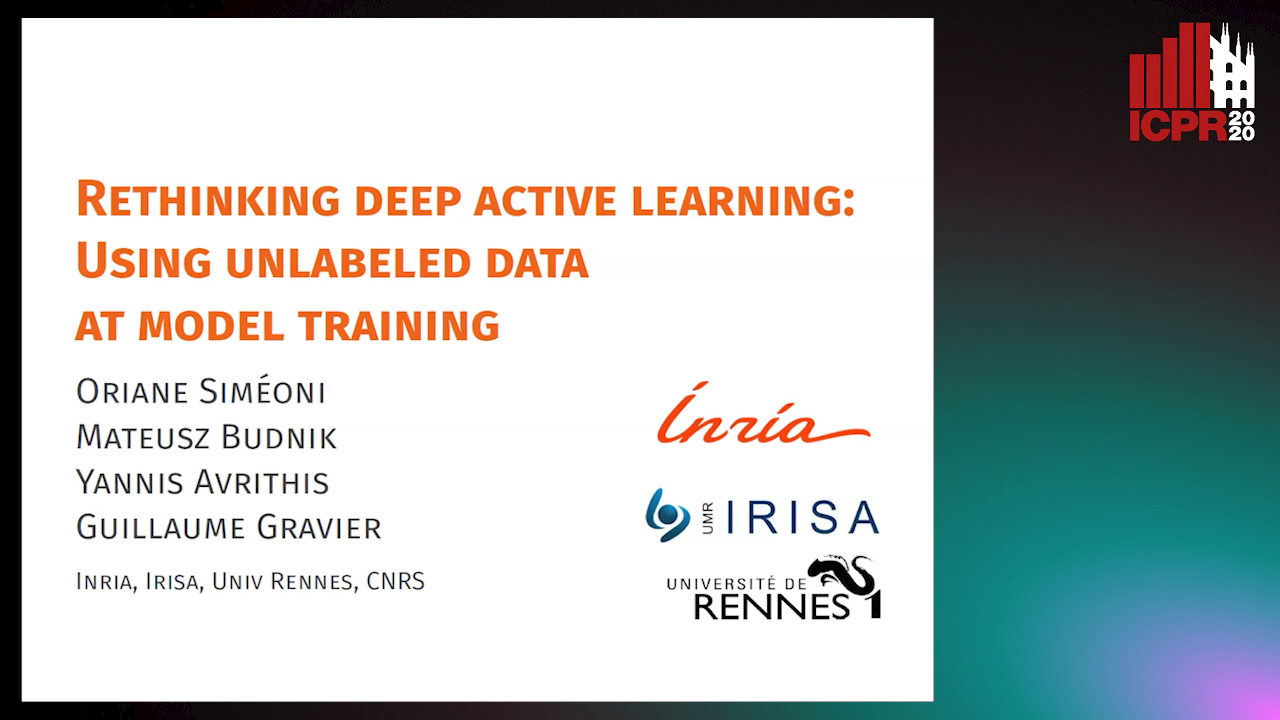
Auto-TLDR; Unlabeled Data for Active Learning
Abstract Slides Poster Similar
Image Representation Learning by Transformation Regression
Xifeng Guo, Jiyuan Liu, Sihang Zhou, En Zhu, Shihao Dong

Auto-TLDR; Self-supervised Image Representation Learning using Continuous Parameter Prediction
Abstract Slides Poster Similar
Class-Incremental Learning with Topological Schemas of Memory Spaces
Xinyuan Chang, Xiaoyu Tao, Xiaopeng Hong, Xing Wei, Wei Ke, Yihong Gong
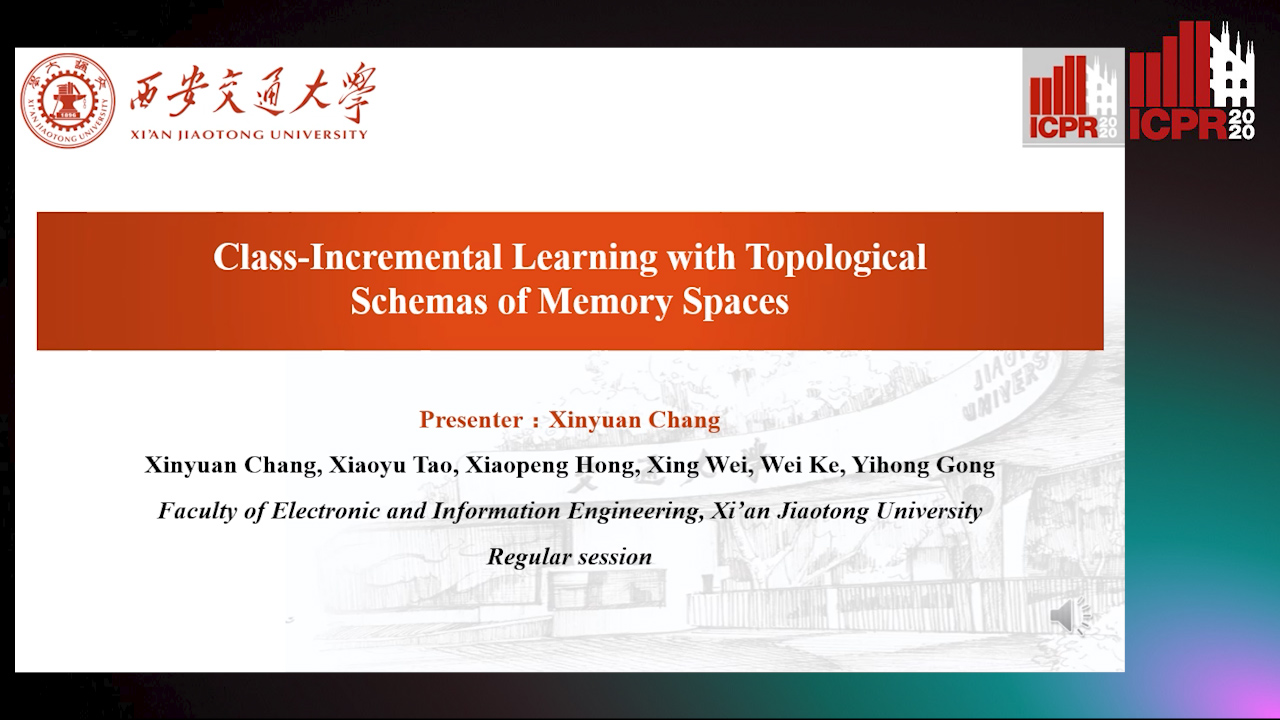
Auto-TLDR; Class-incremental Learning with Topological Schematic Model
Abstract Slides Poster Similar
Learning with Delayed Feedback
Pranavan Theivendiram, Terence Sim

Auto-TLDR; Unsupervised Machine Learning with Delayed Feedback
Abstract Slides Poster Similar
Norm Loss: An Efficient yet Effective Regularization Method for Deep Neural Networks
Theodoros Georgiou, Sebastian Schmitt, Thomas Baeck, Wei Chen, Michael Lew

Auto-TLDR; Weight Soft-Regularization with Oblique Manifold for Convolutional Neural Network Training
Abstract Slides Poster Similar
Is the Meta-Learning Idea Able to Improve the Generalization of Deep Neural Networks on the Standard Supervised Learning?

Auto-TLDR; Meta-learning Based Training of Deep Neural Networks for Few-Shot Learning
Abstract Slides Poster Similar
Multi-Attribute Learning with Highly Imbalanced Data
Lady Viviana Beltran Beltran, Mickaël Coustaty, Nicholas Journet, Juan C. Caicedo, Antoine Doucet

Auto-TLDR; Data Imbalance in Multi-Attribute Deep Learning Models: Adaptation to face each one of the problems derived from imbalance
Abstract Slides Poster Similar
Towards Low-Bit Quantization of Deep Neural Networks with Limited Data
Yong Yuan, Chen Chen, Xiyuan Hu, Silong Peng
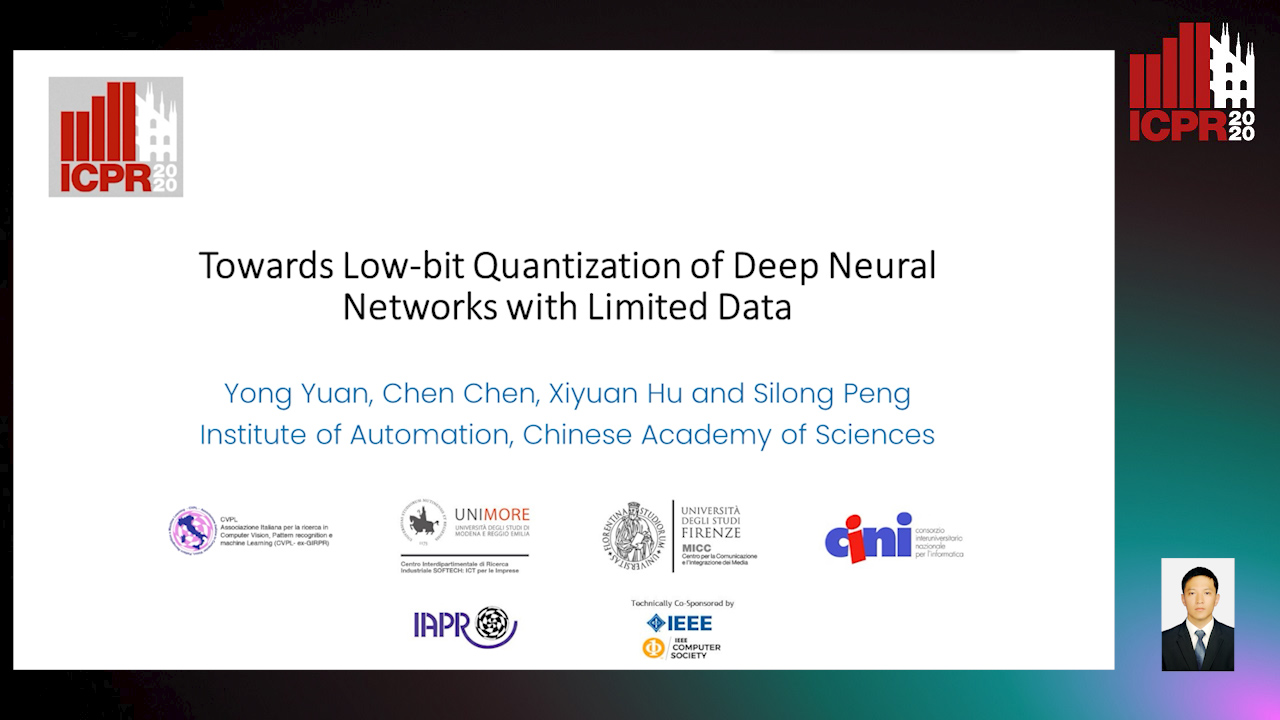
Auto-TLDR; Low-Precision Quantization of Deep Neural Networks with Limited Data
Abstract Slides Poster Similar
Aerial Road Segmentation in the Presence of Topological Label Noise
Corentin Henry, Friedrich Fraundorfer, Eleonora Vig

Auto-TLDR; Improving Road Segmentation with Noise-Aware U-Nets for Fine-Grained Topology delineation
Abstract Slides Poster Similar
Adaptive Noise Injection for Training Stochastic Student Networks from Deterministic Teachers
Yi Xiang Marcus Tan, Yuval Elovici, Alexander Binder

Auto-TLDR; Adaptive Stochastic Networks for Adversarial Attacks
Multi-Order Feature Statistical Model for Fine-Grained Visual Categorization
Qingtao Wang, Ke Zhang, Shaoli Huang, Lianbo Zhang, Jin Fan

Auto-TLDR; Multi-Order Feature Statistical Method for Fine-Grained Visual Categorization
Abstract Slides Poster Similar
Revisiting ImprovedGAN with Metric Learning for Semi-Supervised Learning
Jaewoo Park, Yoon Gyo Jung, Andrew Teoh

Auto-TLDR; Improving ImprovedGAN with Metric Learning for Semi-supervised Learning
Abstract Slides Poster Similar
A Systematic Investigation on End-To-End Deep Recognition of Grocery Products in the Wild
Marco Leo, Pierluigi Carcagni, Cosimo Distante

Auto-TLDR; Automatic Recognition of Products on grocery shelf images using Convolutional Neural Networks
Abstract Slides Poster Similar